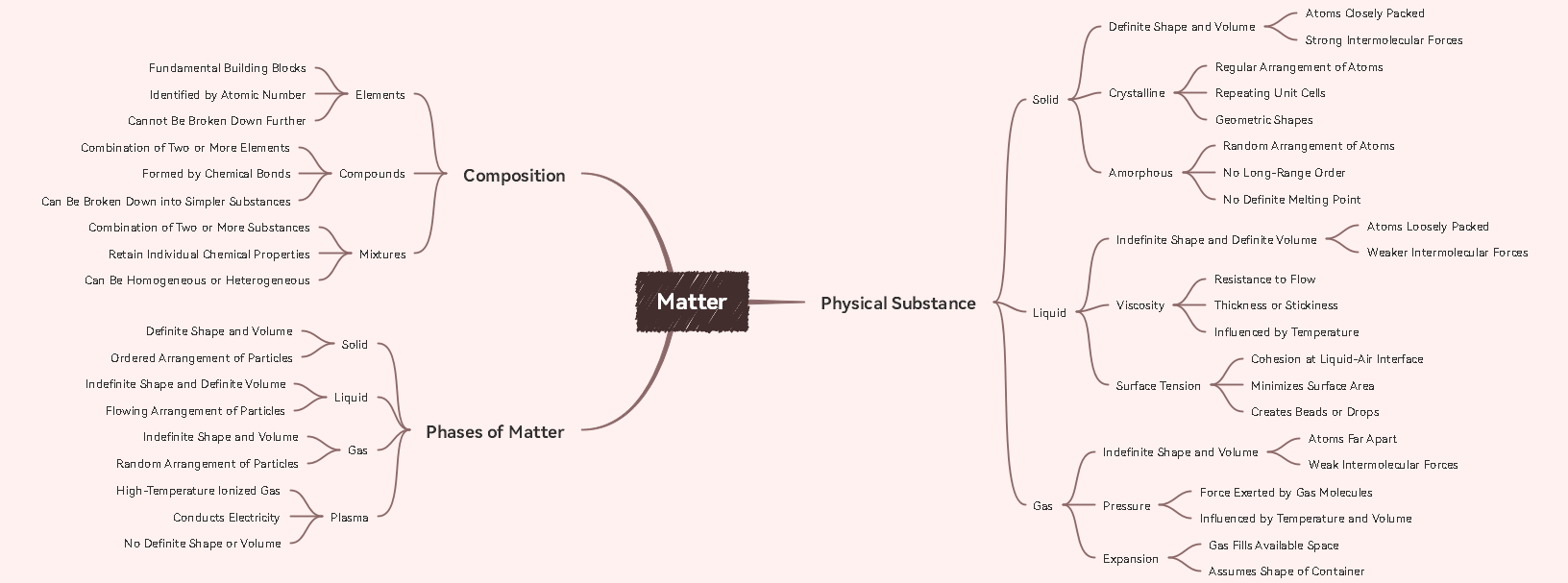We constantly hear that everything on Earth and the universe is made up of matter. It is considered the most basic substance present in anything. However, this simplistic description is just a mere overview. The matter is a very complicated subject of discussion that involves other intricate scientific topics like atoms and elements. That’s why understanding its very nature requires extensive research and a lot of reading.
Don’t worry. A concept map of matter has made it simpler and more handy. This learning instrument simplifies this topic into interactive illustrations that are much easier to consume. Use it to explore the tiny world of particles without relying heavily on textual resources. Read on to learn more.
In this article
Why is it Important?
A concept map of matter is a method of addressing connections between thoughts, space, mass or words similarly that a sentencing chart addresses a sentence's punctuation. A guide addresses the areas of roadways and towns, and a circuit graph handles an electrical apparatus's functions. Each word or expression interfaces with another in a concept map and connects back to the first thought, word, or expression. Concept maps were created to upgrade significant learning in technical studies. An all-around made concept map develops inside a setting outline characterized by an unequivocal "center inquiry".
In contrast, a psyche map frequently has just branches transmitting out from a focal picture. Some exploration proof recommends that the mind store information as creations that follow up on decisive memory content, which is also alluded to as lumps or recommendations. Since concept maps are developed to reflect the association of the explanatory memory framework, they encourage sense-production and effective learning concerning people who make concept maps and the individuals who use them.

Everything You Need to Know About Matter
In general terms, the matter pertains to anything that occupies space. It can be in the solid, liquid, or gas state so long as it has mass and volume. The matter does not refer to a specific example. But in a way, it’s safe to say that any physical object, including air, is made up of matter.
Matter is composed of molecules and atoms. As these tiny particles undergo physical and chemical changes, a brand-new substance with modified properties is created. That’s why matter transforms from one state to another. It’s one of the many interesting facts about matter. There’s more to it that is much better to explore with a concept map of matter.
Understanding the Classifications of Matter
The classification of matter is a fundamental concept in chemistry, providing a systematic way to organize and understand the diverse substances that make up the universe. Matter is anything that has mass and occupies space, and it can be broadly classified into two main categories: pure substances and mixtures.
1. Pure Substances
- Elements
Elements are the simplest form of matter and consist of atoms of the same type. Each element is represented by a unique chemical symbol, such as "H" for hydrogen or "O" for oxygen. Elements cannot be broken down into simpler substances by chemical means.
- Compounds
Compounds are substances of two or more elements chemically combined in fixed ratios. The components of a compound lose their individual properties and create a new substance with distinct characteristics. Water (H₂O) and sodium chloride (NaCl) are examples of compounds.
2. Mixtures
- Homogeneous Mixtures (Solutions)
The components are evenly distributed in inhomogeneous mixtures with a uniform composition. Solutions are a common homogeneous mixture where a solute is dissolved in a solvent. An example is saltwater, where salt (solute) is dissolved in water (solvent).
- Heterogeneous Mixtures
Heterogeneous mixtures have an uneven distribution of components, and their composition may vary at different locations within the mixture. Examples include a mixture of oil and water or a salad with various ingredients.
3. States of Matter
- Solid
Solids have a definite shape and volume. The particles in a solid are closely packed in a regular arrangement, and they vibrate but do not move freely.
- Liquid
Liquids have a definite volume but take the shape of their container. The particles in a liquid are close together but move more freely than in solids.
- Gas
Gases have neither a definite shape nor volume. The particles in a gas are spaced far apart and move rapidly in all directions.
- Colloids
Colloids are a special type of mixture where tiny particles are dispersed in a medium but do not settle out. Colloids often exhibit unique properties, such as the Tyndall effect, where they scatter light. Examples include milk and fog.
Understanding the classification of matter is crucial for chemists as it lays the foundation for more advanced concepts in the field. This knowledge helps scientists predict and manipulate the properties of substances, facilitating the development of new materials and technologies.
Exploring the Realm of Matter with EdrawMind
EdrawMind is a powerful and versatile mind-mapping tool that is invaluable in unraveling matter's intricacies and its classifications. Mind mapping, a visual representation of information using diagrams and hierarchies, is an effective way to organize complex concept maps of matter, making it an ideal companion for delving into the diverse world of matter.
1. Mapping the Classifications of Matter
Begin your journey into the realm of matter by creating a mind map that outlines the classifications. Start with the categories of pure substances and mixtures and branch into elements and compounds. Use EdrawMind's customizable shapes, colors, and connectors to distinguish between elements and their relationships.
2. Visualizing States of Matter
EdrawMind provides a dynamic space to visualize the states of matter—solid, liquid, and gas. Create branches that encapsulate the defining characteristics of each state, allowing for a comprehensive understanding of how particles behave in different arrangements.
3. Unveiling the Complexity of Mixtures
Delve into the world of mixtures with EdrawMind's versatile platform. EdrawMind can showcase the distinction between homogeneous and heterogeneous mixtures, employing colors and icons to illustrate the uniformity or heterogeneity of each mixture.
EdrawMind not only simplifies the complexities of matter but also enhances the learning experience, making it an indispensable tool for anyone embarking on the fascinating journey of understanding the building blocks of our universe.
Matter Concept Map Template with EdrawMind
EdrawMind offers a diverse range of templates that cater to various educational and professional needs. Let's explore some concept maps of matter templates from EdrawMind's gallery, designed to facilitate a comprehensive understanding of the classifications and properties of matter.
1. Circle Packing Template
The Circle Packing Template of the Concept Map of Matter organizes the fundamental ideas surrounding the physical nature of substances. At its core, the concept map delves into the states of matter, covering solids, liquids, gases, and plasma, along with their distinct characteristics. It further explores the microscopic realm, highlighting atoms and molecules as the building blocks of matter.
Additionally, the concept map outlines the properties of matter, distinguishing between physical and chemical properties, and concludes with the important principle of the conservation of matter, encapsulated by the law of conservation of mass. This template provides a visually impactful and logically structured representation of the multifaceted concepts associated with the nature and transformations of matter.
2. Left Template
The Left Template of the Concept Map of Matter in EdrawMind offers a concise and logically structured representation of essential concepts related to the nature and characteristics of matter. Starting with a definition and characteristics of matter, the template explores the composition of matter at the atomic level, emphasizing atoms as the fundamental building blocks.
The states of matter—solid, liquid, and gas—are delineated clearly in terms of particle arrangement and movement. Properties of matter, both physical and chemical, are categorized, providing examples for better understanding. The concept of changes in matter, both physical and chemical, is elucidated, followed by a comprehensive exploration of mixtures and pure substances.
☘️Explore creative Concept Map Templates with EdrawMind! Learn to craft stunning visuals effortlessly, whether you're a beginner or pro. Click now for seamless concept mapping!
3. Reverse Template
The Reverse Template of the Concept Map of Matter offers a unique perspective by exploring the physical characteristics of matter in reverse. The template begins by categorizing matter into solids, liquids, and gases, detailing their attributes such as definite/indefinite shape and volume, intermolecular forces, and special properties like viscosity and surface tension.
It then delves into the composition of matter, distinguishing elements, compounds, and mixtures, elucidating their fundamental differences in terms of atomic structure and chemical bonding. The template proceeds to discuss the phases of matter, highlighting the arrangement in solids, flowing arrangement in liquids, and random arrangement in gases. Finally, it introduces the unique state of plasma and its distinctive properties.
Conclusion
Understanding the classifications and properties of matter is paramount in unraveling the intricacies of our physical world. Whether exploring the states of matter, the composition of atoms and molecules, or the changes and classifications of substances, EdrawMind is an invaluable tool. The Mind Mapping templates offer visually engaging frameworks to organize and comprehend the concepts associated with matter.
By utilizing EdrawMind's templates, users can enhance their learning experience by presenting complex ideas clearly and structured. Embracing EdrawMind for constructing concept maps of matter not only streamlines the process of conceptualization but also fosters a deeper understanding of the principles governing the physical universe.







 below.
below.  below.
below. 

